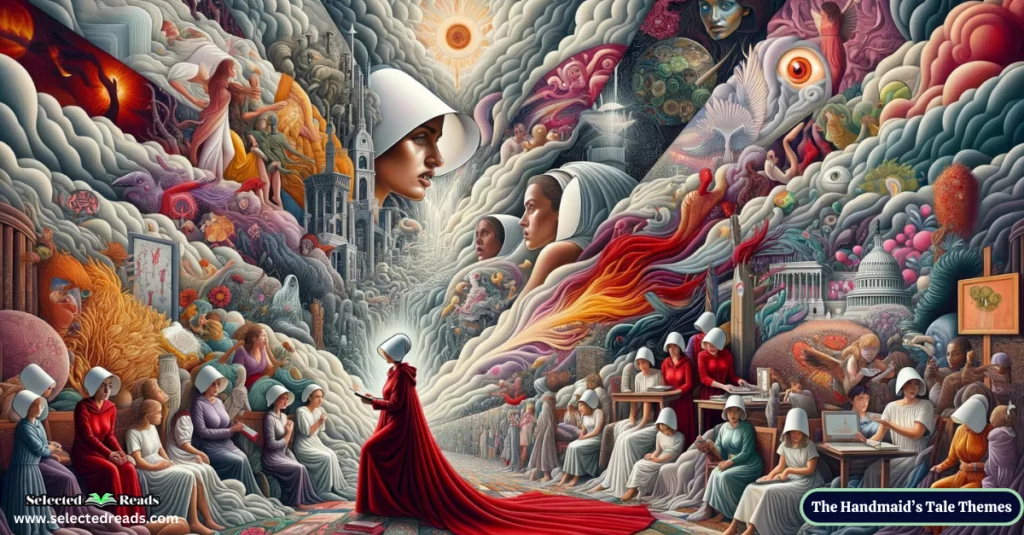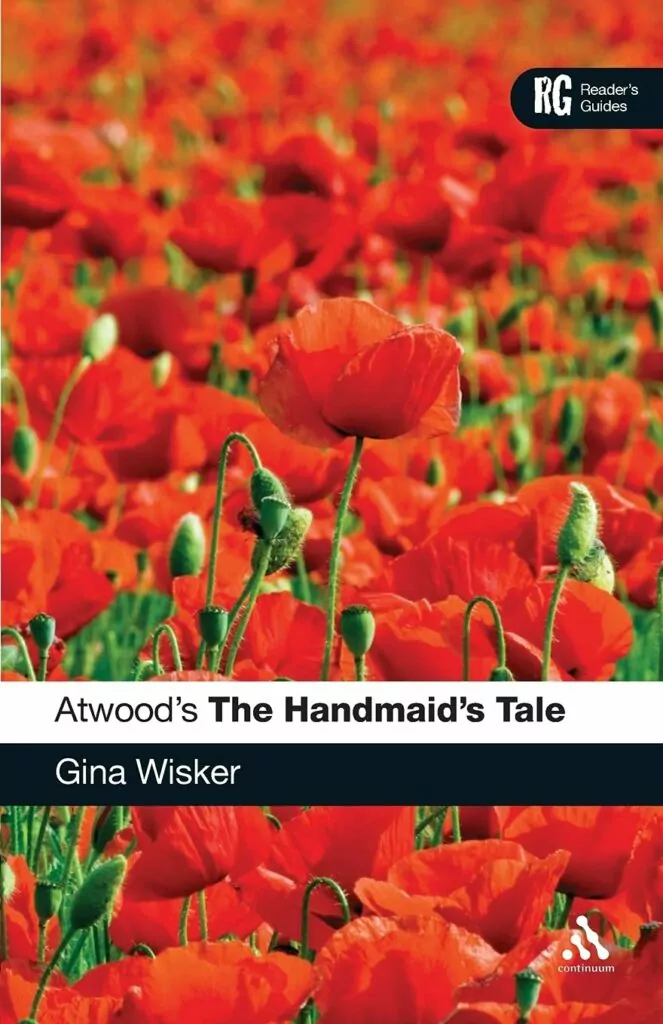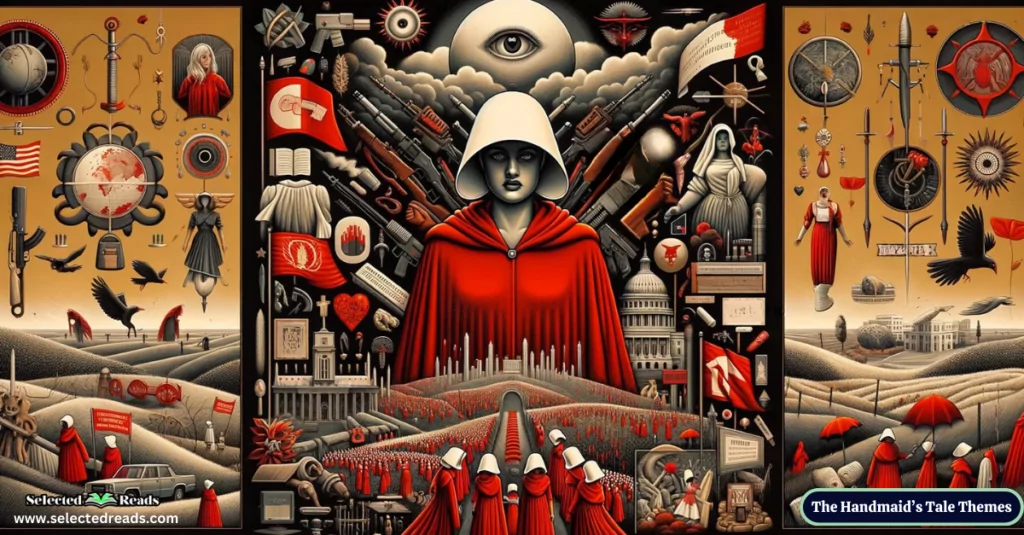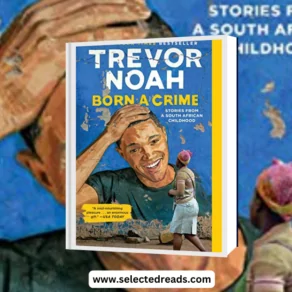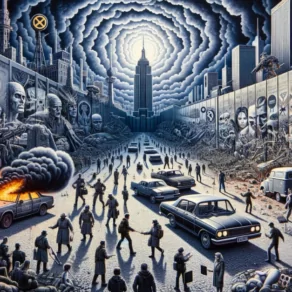In this post, I continue my exploration of Margaret Atwood’s seminal work, “The Handmaid’s Tale.”After I I covered an extended summary of the novel, thought provoking book club questions, and quotes, I move on to talk about the main themes of Atwood’s novel. In doing so, I draw upon a wealth of insights from Gina Whisker’s comprehensive analysis in “Atwood’s The Handmaid’s Tale (Reader’s Guides).”
Whisker’s critical perspectives enrich our understanding of Atwood’s dystopian masterpiece, providing a nuanced lens through which to examine the novel’s complex commentary on women and feminism, the intricacies of language and narrative form, the defining characteristics of dystopian fiction, and the profound critiques of power, control, and religious fundamentalism.
Related: The Handmaid’s Tale Summary, Characters, and Book Club Questions
A Note on Context
Margaret Atwood’s “The Handmaid’s Tale,” published in 1985, is a seminal work deeply rooted in the socio-political context of its time, a period marked by the flourishing of second-wave feminism. This wave of feminism focused intensely on issues central to women’s lives—freedom, reproductive rights, and bodily autonomy. Gina Whisker highlights these concerns, emphasizing how Atwood’s novel resonates with the era’s anxieties about women’s roles and the control exerted over their bodies.
This period also saw the rise of fundamentalist religious regimes, notably in Iran, a country Atwood visited before writing her novel. The emergence of such regimes provided a real-world backdrop against which the dystopian Gilead could be contrasted. Since its publication, the landscape of feminism has evolved, transitioning into post-feminism and the third wave, which brought nuanced critiques of earlier feminist visions and celebrated significant milestones such as Hillary Clinton’s presidential run and Margaret Thatcher’s tenure as the UK’s prime minister.
Despite these advancements, Atwood’s dystopian visions, particularly regarding women’s exclusion from education and public life, eerily echo in the contemporary realities of regions under Taliban control, underscoring the prescience of her work.
Photo: Amazon
Whisker draws connections between Atwood’s thematic concerns and those of contemporaries like John Barth, Thomas Pynchon, and Doris Lessing, as well as the phenomenological explorations of Edmund Husserl, Maurice Merleau-Ponty, and Jean-Paul Sartre. These intellectual influences underscore a fascination with how individuals construct their realities and identities through narratives, a concept that has only become more pertinent with time.
The novel’s exploration of storytelling as a means of making sense of the world anticipates the growing complexities of the 21st century, where issues of technology, environmental degradation, and the specter of fundamentalism have become increasingly pronounced. Whisker’s analysis situates “The Handmaid’s Tale” not only as a product of its time but as a forward-looking critique that anticipates the challenges of the future underscoring Atwood’s role as a visionary storyteller whose work continues to provoke thought and dialogue about our world’s most pressing issues.
Handmaid’s Tale Themes
Margaret Atwood’s “The Handmaid’s Tale” is a rich tapestry of themes that resonate deeply with readers, particularly in its exploration of women and feminism, the nuances of language and narrative style, the characteristics of dystopian fiction, and the critique of power and religious fundamentalism. Delving into these themes, we can appreciate Atwood’s intricate weaving of narrative, character, and societal critique, making the novel a profound commentary on contemporary issues.
a. Women and Feminism
At the core of “The Handmaid’s Tale” is a profound exploration of women’s roles and the constraints imposed upon them in the dystopian world of Gilead. Atwood scrutinizes the reduction of women to their reproductive functions, highlighting the extreme management and control of their bodies and reproductive rights. The novel’s portrayal of women—ranging from Handmaids to Wives to Marthas—underscores the fragmentation of female identity and agency, where each role is strictly defined by the patriarchal state’s needs.
The theme of gender and sexuality is pivotal, as Atwood examines how the Gileadean regime uses these constructs to exert control, stripping women of their sexual autonomy and reducing them to mere vessels for procreation. This critique extends to real-world concerns about reproductive technologies and the ethical implications of controlling women’s bodies, making the novel a feminist manifesto that challenges readers to reflect on issues of autonomy, identity, and resistance.
Atwood’s narrative also delves into feminist theories, particularly the performative nature of gender roles. Through characters like Offred and Moira, the novel explores the acts of compliance and rebellion against these imposed identities, offering insights into the complexities of navigating a world where gender dictates one’s fate.
b. Language, Style, and Form
“The Handmaid’s Tale” is as much about the power of language and storytelling as it is about its characters and plot. Atwood’s use of a first-person narrative gives voice to Offred’s experiences, making her story a personal and political act. The narrative style, blending autobiography with speculative fiction, allows for a deep exploration of how history is recorded and who is trusted to tell it.
Language in Gilead is a tool of control, with certain words banned and new lexicons created to reshape reality. Yet, Atwood also showcases the power of language as resistance—Offred’s narrative is an act of defiance against the silence imposed on women. The novel plays with language, using puns, irony, and double entendres, to undermine Gileadean orthodoxy and highlight the subversive power of storytelling.
c. Dystopias and Genre Fictions
Atwood’s novel is a seminal work in dystopian fiction, projecting contemporary societal flaws and anxieties into a future that feels both fantastical and uncomfortably plausible. Through the lens of Gilead, Atwood critiques issues like environmental degradation, reproductive rights, and the erosion of civil liberties, making the novel a cautionary tale about the potential consequences of unchecked power and ideology.
The Handmaid’s Tale also engages with and subverts traditional genre expectations. Atwood blends elements of science fiction, horror, and political satire, using the dystopian genre not just for entertainment but as a critical tool to examine real-world issues. This engagement with genre fiction allows Atwood to reach a wide audience, using familiar tropes to challenge readers’ perceptions and encourage critical thought about our own society.
d. Power, Control, and Religious Fundamentalism
Atwood’s depiction of Gilead is a scathing critique of power and control, particularly as justified by religious fundamentalism. The novel examines how religion can be manipulated to justify the oppression and subjugation of entire populations. Gilead is a theocracy where biblical justifications are used to enforce rigid social hierarchies and control over individuals, particularly women.
This theme extends to a broader critique of any ideological system that seeks to monopolize power by dictating the minutiae of people’s lives, from their dress to their sexual activity to their role in society. Atwood warns of the dangers of allowing dogmatic beliefs to supplant individual rights and freedoms, making the novel a powerful examination of the intersections between religion, politics, and personal autonomy.
Related: The Handmaid’s Tale Quotes
Final thoughts
Margaret Atwood’s “The Handmaid’s Tale” serves not only as a gripping narrative but also as a profound commentary on the human condition, power dynamics, and societal structures. The themes of women and feminism, language and narrative style, dystopian futures, and the critique of power and religious fundamentalism are interwoven with such skill that they transcend the confines of fiction to reflect on real-world issues.
Gina Whisker’s “Atwood’s The Handmaid’s Tale Reader” provides invaluable insights that deepen our understanding of Atwood’s intentions and the novel’s enduring relevance. In a world where the echoes of Gilead can be discerned in the undercurrents of our own society, “The Handmaid’s Tale” and the scholarly work of Whisker encourage us to reflect, resist, and re-imagine the narratives that shape our lives.



